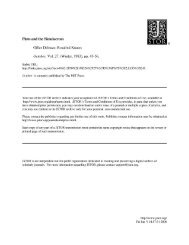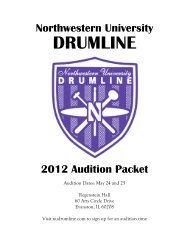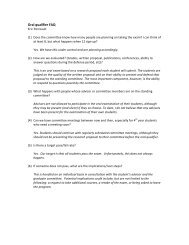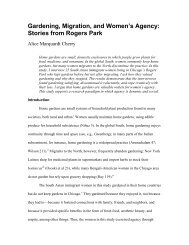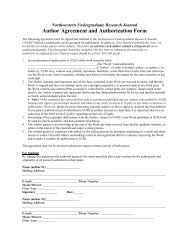research - Associated Student Government, Northwestern University
research - Associated Student Government, Northwestern University
research - Associated Student Government, Northwestern University
Create successful ePaper yourself
Turn your PDF publications into a flip-book with our unique Google optimized e-Paper software.
RESEARCHSouthwest Carrier ModelsTo explore the existence of a Southwest hub premium and the possibility of Southwest to benefit from an umbrellaeffect from the legacy carriers, the study takes a close look at some of Southwest’s pricing practices. As a result,regression models expressed in Equations (2) and (3) are formed.lnprice=α+β1hub+β2lowcost2+β3share+βilegacy_carrieri+βjcontrolsj+ε 2lnprice=α+β1hub+β2lowcost2+β3share+βilegacy_carrier_hubi+βjcontrolsj+ε 3where legacy_carrier iis the set of dummy variables for each legacy carrier (AA, CO, DL, NW, UA, and US), legacy_carrier _hub iis a set of dummy variables for all the legacy carrier hub airports, and controls jis a set of control variables(lnmiles, lnmktpax, and owprop).As illustrated, both equations search for a hubbing effect on Southwest’s part. However, Equation (2) examinesan umbrella effect within the legacy carriers’ entire networks while Equation (3) checks the effect at each individualhub airport of the legacy carriers.III. Empirical ResultsSouthwest Effect ModelTable 1 reports empirical results generated from regressions performed for the exploration of a Southwest effect(Equation 1). In 2000, the legacy carriers all demonstrate a hub premium ranging from Northwest’s 11.4% toUS Airways’ 29.6%. The carrier regressions that showed significance for the Southwest dummy were Continental,Northwest, and United, with the largest negative effect for Continental at -13%.By 2010, the hub premium of all of the carriers decreased with a revised range from American’s 5.1% to Continental’s17.6%. As for the Southwest dummy, the variable remained insignificant for US Airways and the largerapparent Southwest effect for Continental seemed to have disappeared by 2010. While a Southwest effect for Unitedpersisted in 2010, it exhibited a notable decrease in magnitude of about 7%. In contrast, a Southwest effect seemsto have developed since 2000 for both American and Delta, although it is unclear if the change for Delta is from anincreased presence of Southwest in Delta’s original networks or a side effect of Delta’s merger with Northwest, whichalready experienced a Southwest effect in 2000. The latter explanation is more logical because Southwest does notserve Atlanta or Cincinnati, Delta’s two largest hubs before the merger.Compared with the Southwest effect on legacy carriers, the other low-cost carriers presented more uniform behavioras demonstrated by lowcost2 in Table 1. In fact, the variable displays a significantly negative impact at the 1%significance level on all legacy carriers in 2010. Compared with empirical results for 2000, this represents an increasingnegative influence for all legacy carriers except US Airways. For Continental, a negative effect has developedwhile for both American and United, the impact has transformed from insignificantly positive to significantly negative.In addition, the magnitudes of the other low-cost carriers’ negative influences on the legacy carrier fares uniformlyexceeded those of Southwest in 2010. Thus, it seems a larger presence of low-cost carriers as a whole is morepowerful in creating price-decreasing competition than the effect of Southwest alone.Considering the results and changes together, particularly those of American and Delta, a decreasing hub premiumsuggests that the development of a Southwest effect from 2000 to 2010 negatively influences other carriers’pricing. Although some illustrated empirical results are not in line with the notion of a Southwest effect, they arenot implausible. The disappearing Southwest effect for Continental could be a result of Southwest transitioning itslargest operations to different airports. For example, Southwest’s operations at Houston Hobby were third on the listof Southwest’s airports in 2000 but fell to eighth as Southwest started service in Denver and increased the scope ofits operations at Chicago Midway. The changes for US Airways and United are a little more puzzling, though, especiallyconsidering the fact that a Southwest effect for United has lessened while Southwest’s larger operations by 2010were at or near all of the United hubs, Chicago O’Hare, Denver, Los Angeles, San Francisco, and Washington Dulles.Looking more closely at Southwest’s own pricing practices may provide some insight into these otherwise puzzlingresults.Southwest Carrier ModelsTable 2 presents empirical results derived from performing regressions on Southwest with legacy carrier dummiesincluded as explanatory variables (Equation 2). The results for 2000 indicate that compared with the rest ofits network, Southwest was charging premiums of about 6% for flights originating or ending at one of its so-calledhubs. Moreover, Southwest is able to charge higher prices for its flights at the hub airports of three of the legacy carriers,American, Continental, and Northwest, with the highest premium of 9.4% at Northwest’s hubs. These findingsVOLUME 7, 2011-2012NORTHWESTERN UNDERGRADUATE RESEARCH JOURNAL35




